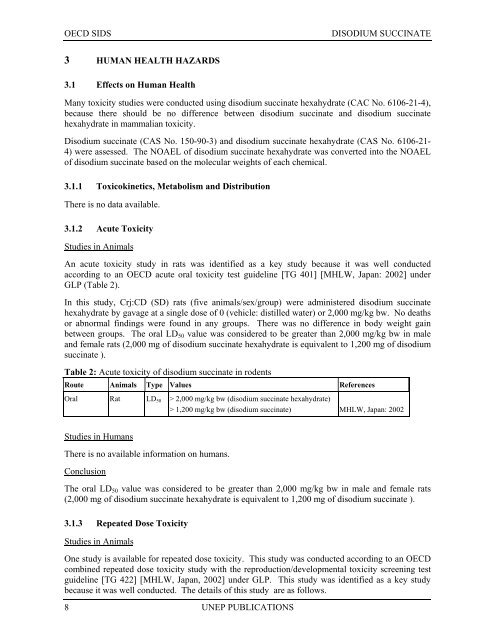DISODIUM SUCCINATE CAS N°: 150-90-3
DISODIUM SUCCINATE CAS N°: 150-90-3
DISODIUM SUCCINATE CAS N°: 150-90-3
Create successful ePaper yourself
Turn your PDF publications into a flip-book with our unique Google optimized e-Paper software.
OECD SIDS<br />
<strong>DISODIUM</strong> <strong>SUCCINATE</strong><br />
3 HUMAN HEALTH HAZARDS<br />
3.1 Effects on Human Health<br />
Many toxicity studies were conducted using disodium succinate hexahydrate (CAC No. 6106-21-4),<br />
because there should be no difference between disodium succinate and disodium succinate<br />
hexahydrate in mammalian toxicity.<br />
Disodium succinate (<strong>CAS</strong> No. <strong>150</strong>-<strong>90</strong>-3) and disodium succinate hexahydrate (<strong>CAS</strong> No. 6106-21-<br />
4) were assessed. The NOAEL of disodium succinate hexahydrate was converted into the NOAEL<br />
of disodium succinate based on the molecular weights of each chemical.<br />
3.1.1 Toxicokinetics, Metabolism and Distribution<br />
There is no data available.<br />
3.1.2 Acute Toxicity<br />
Studies in Animals<br />
An acute toxicity study in rats was identified as a key study because it was well conducted<br />
according to an OECD acute oral toxicity test guideline [TG 401] [MHLW, Japan: 2002] under<br />
GLP (Table 2).<br />
In this study, Crj:CD (SD) rats (five animals/sex/group) were administered disodium succinate<br />
hexahydrate by gavage at a single dose of 0 (vehicle: distilled water) or 2,000 mg/kg bw. No deaths<br />
or abnormal findings were found in any groups. There was no difference in body weight gain<br />
between groups. The oral LD 50 value was considered to be greater than 2,000 mg/kg bw in male<br />
and female rats (2,000 mg of disodium succinate hexahydrate is equivalent to 1,200 mg of disodium<br />
succinate ).<br />
Table 2: Acute toxicity of disodium succinate in rodents<br />
Route Animals Type Values References<br />
Oral Rat LD 50 > 2,000 mg/kg bw (disodium succinate hexahydrate)<br />
> 1,200 mg/kg bw (disodium succinate) MHLW, Japan: 2002<br />
Studies in Humans<br />
There is no available information on humans.<br />
Conclusion<br />
The oral LD 50 value was considered to be greater than 2,000 mg/kg bw in male and female rats<br />
(2,000 mg of disodium succinate hexahydrate is equivalent to 1,200 mg of disodium succinate ).<br />
3.1.3 Repeated Dose Toxicity<br />
Studies in Animals<br />
One study is available for repeated dose toxicity. This study was conducted according to an OECD<br />
combined repeated dose toxicity study with the reproduction/developmental toxicity screening test<br />
guideline [TG 422] [MHLW, Japan, 2002] under GLP. This study was identified as a key study<br />
because it was well conducted. The details of this study are as follows.<br />
8<br />
UNEP PUBLICATIONS
















